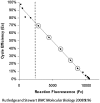Validation of kinetics similarity in qPCR
- PMID: 22013160
- PMCID: PMC3287174
- DOI: 10.1093/nar/gkr778
Validation of kinetics similarity in qPCR
Abstract
Quantitative real-time PCR (qPCR) is the method of choice for specific and sensitive quantification of nucleic acids. However, data validation is still a major issue, partially due to the complex effect of PCR inhibition on the results. If undetected PCR inhibition may severely impair the accuracy and sensitivity of results. PCR inhibition is addressed by prevention, detection and correction of PCR results. Recently, a new family of computational methods for the detection of PCR inhibition called kinetics outlier detection (KOD) emerged. KOD methods are based on comparison of one or a few kinetic parameters describing a test reaction to those describing a set of reference reactions. Modern KOD can detect PCR inhibition reflected by shift of the amplification curve by merely half a cycle with specificity and sensitivity >90%. Based solely on data analysis, these tools complement measures to improve and control pre-analytics. KOD methods do not require labor and materials, do not affect the reaction accuracy and sensitivity and they can be automated for fast and reliable quantification. This review describes the background of KOD methods, their principles, assumptions, strengths and limitations. Finally, the review provides recommendations how to use KOD and how to evaluate its performance.
Figures





Similar articles
-
Shape based kinetic outlier detection in real-time PCR.BMC Bioinformatics. 2010 Apr 12;11:186. doi: 10.1186/1471-2105-11-186. BMC Bioinformatics. 2010. PMID: 20385019 Free PMC article.
-
Kinetic Outlier Detection (KOD) in real-time PCR.Nucleic Acids Res. 2003 Sep 1;31(17):e105. doi: 10.1093/nar/gng106. Nucleic Acids Res. 2003. PMID: 12930979 Free PMC article.
-
Kinetics quality assessment for relative quantification by real-time PCR.Biotechniques. 2005 Sep;39(3):333-4, 336, 338 passim. doi: 10.2144/05393ST01. Biotechniques. 2005. PMID: 16206905
-
Quantitative polymerase chain reaction (PCR) for detection of aquatic animal pathogens in a diagnostic laboratory setting.J Aquat Anim Health. 2011 Sep;23(3):148-61. doi: 10.1080/08997659.2011.620217. J Aquat Anim Health. 2011. PMID: 22216714 Review.
-
The Ultimate qPCR Experiment: Producing Publication Quality, Reproducible Data the First Time.Trends Biotechnol. 2019 Jul;37(7):761-774. doi: 10.1016/j.tibtech.2018.12.002. Epub 2019 Jan 14. Trends Biotechnol. 2019. PMID: 30654913 Review.
Cited by
-
Tutorial: Guidelines for Single-Cell RT-qPCR.Cells. 2021 Sep 30;10(10):2607. doi: 10.3390/cells10102607. Cells. 2021. PMID: 34685587 Free PMC article. Review.
-
Assessment of Toxoplasma gondii levels in zebra mussel (Dreissena polymorpha) by real-time PCR: an organotropism study.Environ Sci Pollut Res Int. 2015 Sep;22(18):13693-701. doi: 10.1007/s11356-015-4296-y. Epub 2015 Mar 14. Environ Sci Pollut Res Int. 2015. PMID: 25772876
-
Integrative Survey of 68 Non-overlapping Upstate New York Watersheds Reveals Stream Features Associated With Aquatic Fecal Contamination.Front Microbiol. 2021 Aug 12;12:684533. doi: 10.3389/fmicb.2021.684533. eCollection 2021. Front Microbiol. 2021. PMID: 34475855 Free PMC article.
-
Adenoviral vector tethering to metal surfaces via hydrolyzable cross-linkers for the modulation of vector release and transduction.Biomaterials. 2013 Sep;34(28):6938-48. doi: 10.1016/j.biomaterials.2013.05.047. Epub 2013 Jun 15. Biomaterials. 2013. PMID: 23777912 Free PMC article.
-
Variation in Expression of Reference Genes across Life Stages of a Bee, Megachile rotundata.Insects. 2021 Jan 6;12(1):36. doi: 10.3390/insects12010036. Insects. 2021. PMID: 33418888 Free PMC article.
References
-
- Murphy Ja, Bustin SA. Reliability of real-time reverse-transcription PCR in clinical diagnostics: gold standard or substandard. Expert. Rev. Mol. Diagn. 2009;9:187–197. - PubMed
-
- International Organization for Standardization. (2005) Microbiology of food and animal feeding stuffs. Polymerase Chain Reaction (PCR) for the detection of food-borne pathogens. General method specific requirements (EN ISO 22174:2005). Geneva.
-
- Lalam NJ. Modelling the PCR amplification process by a size-dependent branching process. Adv. Appl. Probab. 2004;36:602–615.
Publication types
MeSH terms
Substances
LinkOut - more resources
Full Text Sources
Other Literature Sources

